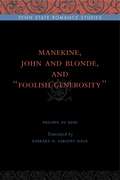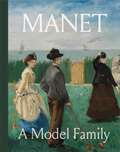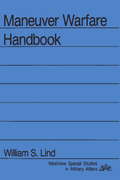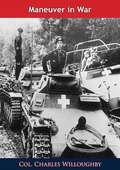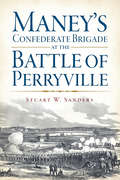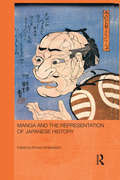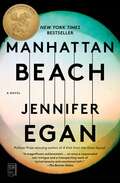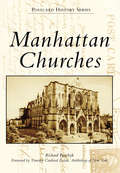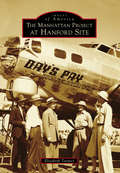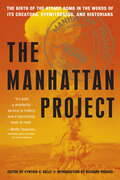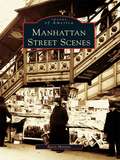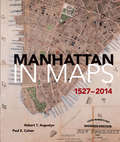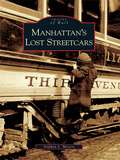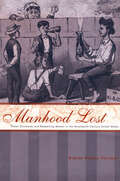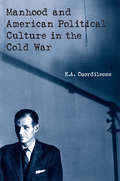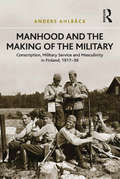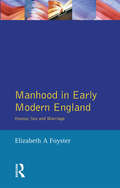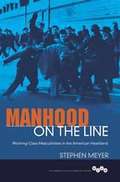- Table View
- List View
Manekine, John and Blonde, and “Foolish Generosity” (Penn State Romance Studies #9)
by Barbara N. Sargent-Baur Philippe De RemiPhilippe de Remi (1200/1210–65) holds a remarkable position in the legacy of the thirteenth-century literary world. A layman, landholder, and professional administrator, rather than a court poet or member of the clergy, Philippe de Remi wrote poems, songs, and long verse narratives that were grounded in his familiarity with the literary genres of his day. While Philippe paid homage to Chrétien de Troyes and other important secular writers of the period, his station in society and an intended audience of family and friends, not patrons, allowed him the freedom to treat courtly conventions with some independence and to explore human motivations across the social spectrum. Barbara Sargent-Baur brings to the modern English-speaking reader a translation of three of Philippe’s most important compositions: his two verse romances, Manekine and John and Blonde, as well as his single short verse tale, “Foolish Generosity.” This volume gathers the first English stand-alone prose translations of these romances, which have been previously published only as line-by-line versions facing the Old French originals. Sargent-Baur’s English translation of “Foolish Generosity” is the first rendering from Old French in any language. These important translations allow increased access to Philippe de Remi’s attractive narrative works, expanding their audience beyond an Old French readership to the wider academic community.
Manet: A Model Family
by Bill Scott Hilton Als Emily Beeny Nancy Locke Adrienne Chaparro Kathryn Kremnitzer Samuel Rodary Juliet Wilson-Bareau Alex Zivkovic Isolde Pludermacher Gianfranco PocobeneA groundbreaking and richly illustrated account of the importance of Manet&’s family to his artAll families are complicated, but the family of Édouard Manet (1832–1883) was more complicated than most. The artist married a piano teacher who worked for his wealthy parents. Her son, born out of wedlock, may have been Édouard&’s, his father&’s, or another man&’s. For all its complexities, Manet&’s family fueled his creativity. They were his most frequent models, and supported him emotionally and financially. Manet: A Model Family is an innovative new exploration of the largely neglected story of the importance of Manet&’s family to his art.Presenting new research on works in which Manet depicted family members, Manet: A Model Family shows how an understanding of the artist&’s family sheds crucial light on his artistic career. Manet&’s mother, wife, stepson, and other relatives—including his sister-in-law, the painter Berthe Morisot—are given long overdue recognition for their roles in Manet&’s life and work. Leading scholars present technical and archival analysis, including redating Madame Auguste Manet, an important, newly conserved painting of Manet&’s mother. In an essay inspired by that canvas, Pulitzer Prize–winning critic Hilton Als reconsiders Manet&’s formative relationship with his mother and his bourgeois Parisian roots.With its original account of Manet&’s domestic relationships and personal life, Manet: A Model Family humanizes the artist and his contributions to the birth of modernism.Published in association with the Isabella Stewart Gardner MuseumExhibition ScheduleIsabella Stewart Gardner Museum, BostonOctober 10, 2024–January 20, 2025
Maneuver Warfare Handbook
by William S LindManeuver warfare, often controversial and requiring operational and tactical innovation, poses perhaps the most important doctrinal questions currently facing the conventional military forces of the U.S. Its purpose is to defeat the enemy by disrupting the opponent's ability to react, rather than by physical destruction of forces. This book develops and explains the theory of maneuver warfare and offers specific tactical, operational, and organizational recommendations for improving ground combat forces. The authors translate concepts-too often vaguely stated by manuever warfare advocates-into concrete doctrine. Although the book uses the Marine Corps as a model, the concepts, tactics, and doctrine discussed apply to any ground combat force.
Maneuver Warfare Handbook
by William S LindManeuver warfare, often controversial and requiring operational and tactical innovation, poses perhaps the most important doctrinal questions currently facing the conventional military forces of the U. S. Its purpose is to defeat the enemy by disrupting the opponent’s ability to react, rather than by physical destruction of forces. This book develops and explains the theory of maneuver warfare and offers specific tactical, operational, and organizational recommendations for improving ground combat forces. The authors translate concepts--too often vaguely stated by manuever warfare advocates--into concrete doctrine. Although the book uses the Marine Corps as a model, the concepts, tactics, and doctrine discussed apply to any ground combat force.
Maneuver Warfare Handbook
by William S LindManeuver warfare, often controversial and requiring operational and tactical innovation, poses perhaps the most important doctrinal questions currently facing the conventional military forces of the U.S. Its purpose is to defeat the enemy by disrupting the opponent's ability to react, rather than by physical destruction of forces. This book develops and explains the theory of maneuver warfare and offers specific tactical, operational, and organizational recommendations for improving ground combat forces. The authors translate concepts-too often vaguely stated by manuever warfare advocates-into concrete doctrine. Although the book uses the Marine Corps as a model, the concepts, tactics, and doctrine discussed apply to any ground combat force.
Maneuver Warfare Handbook
by William S. LindManeuver warfare, often controversial and requiring operational and tactical innovation, poses perhaps the most important doctrinal questions currently facing the conventional military forces of the U. S. Its purpose is to defeat the enemy by disrupting the opponent's ability to react, rather than by physical destruction of forces. This book develops and explains the theory of maneuver warfare and offers specific tactical, operational, and organizational recommendations for improving ground combat forces. The authors translate concepts-too often vaguely stated by manuever warfare advocates-into concrete doctrine. Although the book uses the Marine Corps as a model, the concepts, tactics, and doctrine discussed apply to any ground combat force.
Maneuver in War
by Col. Charles WilloughbyAn excellent study on the theory of maneuver with many historical illustrations, it is as applicable today as it was when published in 1939.Military movements play critical roles at all three levels of war: tactical, operational, and strategic. This essay explores how the principles of war apply specifically to military movements in the rapidly changing global environment of the late twentieth century. Military movement is critical because it is a means by which ways are made effective to achieve ends. Military movement or the credible potential for movement is essential for the application of each of the principles of war to any conceivable military situation, whether deterrence or combat. Maneuver superiority is essential to the success of future military operations.
Maney's Confederate Brigade at the Battle of Perryville (Civil War Series)
by Stuart W. SandersOn October 8, 1862, forty thousand Union and Confederate soldiers clashed at Perryville, Kentucky, in the state's largest Civil War battle. Of those who fought, none endured as much as the Tennessee and Georgia soldiers who composed Brigadier General George Maney's brigade. The Confederate unit entered the fray to save other Southern regiments and, in doing so, experienced deadly resistance. Many of those involved called the brigade's encounter the toughest of the Civil War, as several of Maney's regiments suffered casualties of 50 percent or greater. Despite relentless fighting, the Confederates were unable to break the Union line, and the Bluegrass State remained in Federal control. Join author Stuart W. Sanders as he chronicles Maney's brigade in the Battle of Perryville.
Manga and the Representation of Japanese History (Routledge Contemporary Japan Series)
by Roman RosenbaumThis edited collection explores how graphic art and in particular Japanese manga represent Japanese history. The articles explore the representation of history in manga from disciplines that include such diverse fields as literary studies, politics, history, cultural studies, linguistics, narratology, and semiotics. Despite this diversity of approaches all academics from these respective fields of study agree that manga pose a peculiarly contemporary appeal that transcends the limitation imposed by traditional approaches to the study and teaching of history. The representation of history via manga in Japan has a long and controversial historiographical dimension. Thereby manga and by extension graphic art in Japanese culture has become one of the world’s most powerful modes of expressing contemporary historical verisimilitude. The contributors to this volume elaborate how manga and by extension graphic art rewrites, reinvents and re-imagines the historicity and dialectic of bygone epochs in postwar and contemporary Japan. Manga and the Representation of Japanese History will be of interest to students and scholars of Asian studies, Asian history, Japanese culture and society, as well as art and visual culture
Manhattan Beach Chronicles
by Jan DennisAn isolated ocean-view village on the dunes above South Santa Monica Bay, Manhattan Beach grew with the arrival of railroads. This quaint, upscale jewel of the Los Angeles County coast has been known for its cottage-style living, the Metlox Pottery Company and the iconic pier. These diverse stories mix the city's controversies, including the still unsolved 1936 murder of Reid Russell, with true tales of pioneering women, controversial politics and the vicissitudes of seaside city development. Join author Jan Dennis, a former Manhattan Beach city mayor, on this illuminating tour through the issues and eras of her beloved city's history.
Manhattan Beach: A Novel
by Jennifer Egan<P>ElleAnna Kerrigan, nearly twelve years old, accompanies her father to visit Dexter Styles, a man who, she gleans, is crucial to the survival of her father and her family. She is mesmerized by the sea beyond the house and by some charged mystery between the two men. <P>Years later, her father has disappeared and the country is at war. Anna works at the Brooklyn Naval Yard, where women are allowed to hold jobs that once belonged to men, now soldiers abroad. She becomes the first female diver, the most dangerous and exclusive of occupations, repairing the ships that will help America win the war. <P>One evening at a nightclub, she meets Dexter Styles again, and begins to understand the complexity of her father’s life, the reasons he might have vanished. <P>With the atmosphere of a noir thriller, Egan’s first historical novel follows Anna and Styles into a world populated by gangsters, sailors, divers, bankers, and union men. <P>Manhattan Beach is a deft, dazzling, propulsive exploration of a transformative moment in the lives and identities of women and men, of America and the world. It is a magnificent novel by the author of A Visit from the Goon Squad, one of the great writers of our time. <P><b>Winner of the 2018 Andrew Carnegie Medal for Fiction</b> <P><b>A New York Times Bestseller</b>
Manhattan Churches (Postcard History Series)
by Richard Panchyk Timothy Cardinal DolanManhattan Churches celebrates the wonderful diversity of churches in New York City's oldest borough. The book takes an in-depth look at a wide array of awe-inspiring structures, from Lower Manhattan and Midtown to the Upper East Side, Upper West Side, and Harlem. From Trinity Church and St. Patrick's Cathedral to the Little Church Around the Corner and the Cathedral of St. John the Divine, the city's churches are a fascinating part of New York's religious, cultural, and architectural history.
Manhattan Moves Uptown: An Illustrated History (New York City)
by Charles LockwoodThis fascinating chronicle traces New York City's growth from Wall Street at the end of the Revolutionary War to Harlem at the turn of the twentieth century. Documenting the frantic construction and speculative frenzy that swept through Manhattan in the nineteenth century, it explores the development of the city's landmark neighborhoods as the rural landscape of Upper Manhattan gave way street by street to today's fashionable residential and commercial districts. Compiled from newspaper archives and richly illustrated with historic images, Manhattan Moves Uptown reveals bygone days when Greenwich Village was a real village and Midtown was a cluster of shacks surrounded by garbage dumps and slaughter houses. The rise of Union Square, Murray Hill, Broadway, the Upper West Side, and other well-known areas are recounted, along with trends ranging from the first luxury department store to the earliest tenement houses. A captivating account of metropolitan flux and expansion, this book offers memorable historic views of one of the nation's richest, most powerful, and most exciting cities.
Manhattan Passions: True Tales of Power, Wealth and Excess
by Ron RosenbaumThe rich get richer--and nastier.
Manhattan Project at Hanford Site, The
by Elizabeth ToomeyThe Manhattan Project at Hanford Site describes the top-secret effort undertaken during World War II to develop a weapon never imagined at "Site W" or "Hanford Engineer Works," one of three sites selected in the United States (plus Los Alamos and Oak Ridge) to research and produce weapons that were ultimately used to bomb Hiroshima and Nagasaki and end World War II. It was a research and engineering feat of unimaginable proportion, and the total project cost for all three sites was $2.1 billion--an unthinkable amount for a country that was coming out of the Great Depression. It is a story of gumption, resolve, tenacity, patriotism, pride, and selflessness for the thousands of people who worked multiple shifts, seven days a week, in a hot, dry, and desolate desert, never knowing what they were working on. It is a tribute to American resolve in the face of overwhelming adversity.
Manhattan Project: The Birth of the Atomic Bomb in the Words of Its Creators, Eyewitnesses, and Historians
by Richard Rhodes Cynthia C. KellyThe first collection ever of the writings and insights of the original creators of the atomic bomb, along with pieces by the most important historians and interpreters of the subject, is now in paperback. Born out of a small research program begun in 1939, the Manhattan Project eventually employed more than 130,000 people, including our foremost scientists and thinkers, and cost nearly $2 billion?and it was operated under a shroud of absolute secrecy. This groundbreaking collection of documents, essays, articles, and excerpts from histories, biographies, plays, novels, letters, and the oral histories of key eyewitnesses is the freshest, most exhaustive exploration yet of the topic. Compiled by experts at the Atomic Heritage Foundation, the book features first-hand material by Albert Einstein, Leslie Groves, J. Robert Oppenheimer, Leo Szilard, Enrico Fermi, Richard Feynman, Niels Bohr, Henry Stimson, and many others. Dozens of photographs depict key moments and significant figures, and concise explanatory material accompanies each selection. The project's aftermath and legacy are covered as well, making this the most comprehensive account of the birth of the atomic age.
Manhattan Street Scenes
by Barry MorenoThis richly nostalgic volume highlights some of the mostextraordinary periods of New York City's history, including the first decade of the 20th century, the Roaring Twenties, and the later years that led to the Great Depression and World War II. Abounding with evocative period photography,Manhattan Street Scenes invites readers into an age when no man walked the streets without wearing a hat, when buying liquor was illegal, when vaudeville and Broadway theaters were aglitter with stars and wildly popular songs, and when the city's streets teemed with motorcars such as Packards, Studebackers, and Dusenbergs. Additionally, the inclusion of rare, never before published police and crime photography enhances the charm of this volume.
Manhattan in Maps 1527-2014
by Eric W. Sanderson Paul E. Cohen Robert T. AugustynMore than 400 years of history unfold in the pages of this lavishly illustrated volume, which presents sixty-five full-color maps of America's oldest major city. This is Manhattan's first atlas of historical maps, gathered from private collections and libraries throughout the world. From Giovanni da Verrazzano's first glimpse of New York Harbor in the sixteenth century to a modern aerial survey of the island, these rare and beautiful maps recount the city's urban and social history.Each map is accompanied by a fascinating essay that explores its portrait of New York's changing physical and social contours. Examples from the Dutch colonial period reflect the findings of Manhattan's earliest European settlers. New York was the command center for British forces during the Revolution, and wartime maps painstakingly delineate the battleground's streams, swamps, hills, and shoreline. Frederick Law Olmsted and Calvert Vaux's original plan for Central Park appears here, along with charts that reveal the development of the Manhattan grid as well as the expansion of ethnic neighborhoods, midtown vice, and the subway system. Each entry cites the map's title, date of creation and publication, cartographer, medium, and the institution or private collection where the map is archived. There is a Foreword by Tony Hiss, a bibliography, and complete index, as well as a new Introduction by Marguerite Holloway, author of The Measure of Manhattan (2013), and an essay by landscape ecologist Eric W. Sanderson, which includes a map by Mr. Sanderson and cartographer Markley Boyer providing a view of Manhattan Island as Henry Hudson might have seen it in 1609. "Here then is the story of Manhattan as it was, as it is, and even as it might have been. Maps tell the story. All the output of all the journalists who have written about Manhattan does not succeed half as well."--Ted Koppel, former managing editor and anchor, Nightline"Manhattan in Maps enables us all to look through layers of time and concrete to the ground of life in this city through over three centuries. . . . an invaluable visual guide to New York City history."--Alice C. Hudson, Chief, Map Division, Center for Humanities, The New York Public Library
Manhattan's Lost Streetcars
by Stephen L. MeyersBy the first quarter of the 20th century, Manhattan had well over 400 miles of streetcar trackage, an investment of several million dollars. Less than 50 years later, the rail system had completely vanished. Manhattan's Lost Streetcars chronicles the finance, political pressures, and advancing technology behind Gotham's streetcar networks from 1890 to 1935. The story ends with the dismantling of the system. Manhattan's Lost Streetcars recalls a bygone era when public rail transportation was aboveground and New Yorkers rode the Metropolitan Street Railway, the Green Lines, the Manhattan Bridge Three Cent Line, and the Brooklyn & North River line, among others. It features images of the independent rail companies and the individual lines that made up a vast public transportation network in Manhattan.
Manhattan, '45
by Jan MorrisOn June 25, 1945, 14,000 American service men and women sailed into New York aboard the British liner Queen Mary. They were the first big contingent to return from the victory over Nazi Germany, and the city that awaited them stood at a historical climax of power, confidence, hope, and prestige, still curiously laced with a provincial innocence. In this new book by one of the most gifted stylists in the English language, we disembark at Manhattan with the returning GIs, and discover for ourselves how the city was. We ride the vanished trolleys, the El, the Hudson River ferry-boats. We meet characters as disparate as developer Robert Moses, Sherman Billingsley of the Stork Club, painter Jackson Pollock, and Joe Gould, a Greenwich Village denizen who claimed to speak the seagull language. We explore Harlem and the Lower East Side, we inspect the menu at the legendary Le Pavillon, we board the Twentieth Century Limited, and we swoon to Sinatra at Radio City Music Hall. Few aspects of Manhattan are neglected in Jan Morris's affectionate evocation--slum and Social Register are both here, City College and Times Square, the genius of the New York School and the panache of the New York Fire Department. Manhattan '45 gets its title, so the author tells us in her epilogue, because it sounds "partly like a kind of gun, and partly like champagne," and in these pages the victorious, celebratory, and explosive Manhattan of four decades ago finds a permanent souvenir.
Manhood Lost: Fallen Drunkards and Redeeming Women in the Nineteenth-Century United States (New Studies in American Intellectual and Cultural History)
by Elaine Frantz ParsonsIn fiction, drama, poems, and pamphlets, nineteenth-century reformers told the familiar tale of the decent young man who fell victim to demon rum: Robbed of his manhood by his first drink, he slid inevitably into an abyss of despair and depravity. In its discounting of the importance of free will, argues Elaine Frantz Parsons, this story led to increased emphasis on environmental influences as root causes of drunkenness, poverty, and moral corruption—thus inadvertently opening the door to state intervention in the form of Prohibition. Parsons also identifies the emergence of a complementary narrative of "female invasion"—womanhood as a moral force powerful enough to sway choice. As did many social reformers, women temperance advocates capitalized on notions of feminine virtue and domestic responsibilities to create a public role for themselves. Entering a distinctively male space—the saloon—to rescue fathers, brothers, and sons, women at the same time began to enter another male bastion—politics—again justifying their transgression in terms of rescuing the nation's manhood.
Manhood and American Political Culture in the Cold War
by K.A. CuordileoneManhood and American Political Culture in the Cold War explores the meaning of anxiety as expressed through the political and cultural language of the early cold war era. Cuordileone shows how the preoccupation with the soft, malleable American character reflected not only anti-Communism but acute anxieties about manhood and sexuality. Reading major figures like Arthur Schlesinger Jr., Adlai Stevenson, Joseph McCarthy, Norman Mailer, JFK, and many lesser known public figures, Cuordileone reveals how the era’s cult of toughness shaped the political dynamics of the time and inspired a reinvention of the liberal as a cold warrior.
Manhood and the Making of the Military: Conscription, Military Service and Masculinity in Finland, 1917–39
by Anders AhlbäckWhen Finland gained its independence from Russia in 1917, the country had not had a military for almost two decades. The ensuing creation of a new national conscript army aroused intense but conflicting emotions among the Finns. This book examines how a modern conscript army, born out of a civil war, had to struggle through social, cultural and political minefields to find popular acceptance. Exploring the ways that images of manhood were used in the controversies, it reveals the conflicts surrounding compulsory military service in a democratic society and the compromises made as the new nation had to develop the will and skill to defend itself. <P><P> Through the lens of masculinity, another picture of conscription emerges, offering new understandings of why military service was resisted and supported, dreaded and celebrated in Finnish society. Intertwined with the story of the making of the military runs the story of how manhood was made and remade through the idealized images and real-life experiences of conscripted soldiers. Placing interwar Finland within a broad European context, the book traces the origins of competing military traditions and ideological visions of modern male citizenship back to their continental origins. It contributes to the need for studies on the impact of the Great War on masculinities and constructions of gender among military cultures in the peacetime period between the two world wars.
Manhood in Early Modern England: Honour, Sex and Marriage (Women And Men In History)
by Elizabeth A FoysterThis is the first book to focus on the relationships which men formed with their wives in early modern England, making it an important contribution to a new understanding of English, social, family, and gender history. Dr Foyster redresses the balance of historical research which has largely concentrated on the public lives of prominent men. The book looks at youth and courtship before marriage, male fears of their wives' gossip and sexual betrayal, and male friendships before and after marriage. Highlighted throughout is the importance of sexual reputation. Based on both legal records and fictional sources, this is a fascinating insight into the personal lives of ordinary men and women in early modern England.
Manhood on the Line: Working-Class Masculinities in the American Heartland (The Working Class in American History)
by Stephen MeyerStephen Meyer charts the complex vagaries of men reinventing manhood in twentieth century America. Their ideas of masculinity destroyed by principles of mass production, workers created a white-dominated culture that defended its turf against other racial groups and revived a crude, hypersexualized treatment of women that went far beyond the shop floor. At the same time, they recast unionization battles as manly struggles against a system killing their very selves. Drawing on a wealth of archival material, Meyer recreates a social milieu in stunning detail--the mean labor and stolen pleasures, the battles on the street and in the soul, and a masculinity that expressed itself in violence and sexism but also as a wellspring of the fortitude necessary to maintain one's dignity while doing hard work in hard world.
